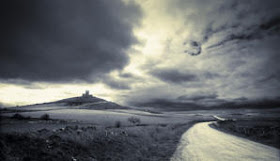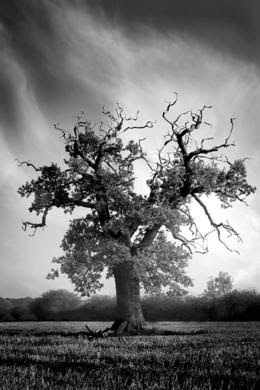Mono Mode
Colours such as red and green may appear different in colour but may tonally record the same.Think about the elements within your image and whether there is a sufficient degree of contrast between them. If you’re having difficulty visualising in black and white, try setting your colour mode to mono using the menu. This will give you a b&w image on the LCD.
Mono Filters
Although it’s generally best to shoot in colour and convert to mono later, the mono mode is useful as a visualisation tool (you can go back to colour for the actual shot after viewing) and also for shooting in b&w if you’re planning to go straight to print from the card without your images passing through a PC.If you prefer this method of shooting you may want to experiment with an ‘old school’ technique used by film photographers – use coloured filters to darken certain areas of the shot while lightening others. Yellow, orange and red filters have a progressively darkening effect on a blue sky, making cloud formations stand out. On a PC a similar tonal manipulation effect can be achieved in Photoshop and Elements using the Channel Mixer.Landscapes photography Ingredients
Landscapes photography cover a vast range of subject matter, from expansive views to intimate details, but there are certain key ingredients that occur again and again in the most popular landcape photographs.
there are certain key ingredients that occur again and again in the most popular landcape photographs.Water
The relationship between land and water is a favourite topic for landscapes photography shooting, and black and white photography is no different. The texture and fluidity of the water against rocks and rugged landscapes contrasts well, as it adds movement to an otherwise static image. Controlling your shutter speed will accentuate how you want to represent this movement; using a slow shutter speed will blur the motion of the water, giving the image a peacefully serene quality, while a fast shutter speed will freeze the water completely, giving you sharp detail. Reflections in water are another recurring theme offering endless opportunities.(read about Photographing streams and rivers) .
Patterns and Textures

A popular motif in landscape photography is to emphasise patterns. Occurring frequently in nature, the echoes from repeated patterns can make for a strong image when isolated from their surroundings.
Textures, too, offer a rich vein of subject matter for the b&w photographer. Think of tree bark, the roughness of rocks, the texture of grass. Strong directional side-lighting is best for enhancing texture, such as the kind you get early and late in the day in sunny conditions.
read about (Tips on photographing household objects).
Skies and Cloudscapes

Clouds as an element within your picture can be very subtle in changing the whole mood of an image. They can add a sense of drama or throw a veil of calmness across a picture. Where the horizon lies within an image will have an effect on the way an image is viewed, with a low horizon accentuating the mood of the sky and clouds and making this a dominating factor. Sometimes the clouds can become a subject in their own right, but you would still want to show a slither of land in the bottom of the frame in order to give a point of scale and reference.

Trees
One of the most powerful motifs in landscape photography is that of the lone tree, standing proud and defiant (read article about Tree Photography Techniques). Trees are incredibly photogenic, at any time of the year. The bare twisted branches of winter trees set against a featureless sky can make a great subject for b&w, but even in the height of summer there are few sights as magnificent as a single mighty oak, beech or cedar tree, especially if you can catch it in the right lighting. They can either form the entire focus of your image, or – placed at just the right part of the frame – serve as a useful focal point within a wider landscape photography. For best results, as always, the beginning and end of the day are the best times to capture them.read also Amazing landscape photography from Ian Moran

